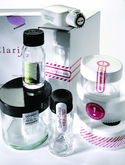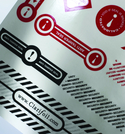Securing new labelling business
17 March 2011Someone else’s problem can open up opportunities for others, and a case in point is the growing market for security-related labels and tags, writes Joanne Hunter.
Expertise in devices to protect against counterfeiting and anti-theft, and anti-tampering products can open new markets for label producers and bring valuable business. The sector depends on innovation and the development of ever more sophisticated materials, systems and production methods. It also relies on vigilance to keep technical intelligence within company walls.
A suitable combination of materials, press configurations, inks and systems can turn a selfadhesive label into an effective security aid. But, clearly, as technical details must be protected, any discussion on the topic is limited so as to preserve confidentiality.
Security and ‘intelligent’ labels in Europe use visible or invisible inks, special varnishes, embedded fibres or threads in labelstocks, optical-variable films, hologram foils, special electronic origination software, traceable elements, and self-destruct (frangible) labelstocks.
The mainstream converter can offer aspects of security labelling if it can conform to required standards and conditions. Jeremy Plimmer is Secretary-General of Product & Image Security Foundation (PISEC), the international forum for manufacturers, users and suppliers in the market, formerly known as Label & Tag Security International (LTSI). He believes there is room for new entrants whose production methods are set up with strict controls over wastage. It might entail raising the level of security at the factory site and for personnel, and implementing stringent auditing procedures, he notes.
Manfred Goretzki, Editor Infosecura, picks up on this point, noting that converters of security labels share similar problems faced by printers of security documents and banknotes: “For labels, it depends of course on the question of ‘how secure’. Affixing a hologram to a package or bottle is easy from a converter’s point of view. And while it may be difficult to counterfeit the hologram, the label can only be secure when it comes from a supplier who guarantees total accountability in the production process, with all raw materials counted and totally secured, all semi-finished products secured in vaults during intermediate storage, etc.
“All items produced must be counted, including those that are not fit for further use. All holograms must be able to be traced and there must not be any possibility of theft, either by insiders or outsiders. That means that the production facility must be secured with perimeter fences, guards, electronic surveillance, and no unaccompanied visitors must be allowed in the factory, etc.
“The same applies to all other security features which are added to the label, and the printer or converter also must have the same facilities. If the premises of the printer or converter, or of the final client are not totally secure against theft, it really doesn’t matter how secure the label itself is: it is not a secure label, even if it looks like one.
“The second point is even more difficult. If the final purpose of using a secure label is not simply track and trace, but if it is there to protect the end-user against counterfeits, for example medicines, it would be totally useless if neither the seller nor the buyer of the product knows how to tell a genuine product –and hence label – from a counterfeit one. This is very difficult, because it means educating the public sufficiently, without giving the counterfeiter an easy prescription of how to fool the public. Every company has to find its own best solution for this.
“There has to be a complicated, difficult and expensive to counterfeit first level security element, such as a hologram, kinegram, OVD (optical variable device), colour changing ink, etc. The features of this device should be known by the end-user (the retailer and customer). Then there could be a secondary device, detectable with a simple tool, such as UV printing, security fibres or plancettes in the paper of the label, micro-printing, readable only with a magnifying glass, or even a watermark. And finally there are forensic features, only detectable in a lab. These could also be used for track and trace.
“There are some clever security features on the market, many developed for banknotes. One that comes to mind is called Motion, a very sophisticated security stripe made by Crane in Sweden, which is now being used on the new US$100 banknote.”
On its website. US based company PPG Industries promotes the high level protection it can offer users of Teslin security-grade material, which incorporates customised combinations of covert and forensic elements within Teslin substrate during production. In addition to the fact that the elements are not accessible on the surface for illicit alteration, there is controlled use of raw materials, fabricated product, waste and trim. And for a secure supply chain, it is sold only directly from PPG under a security contract.
Commercial security applications require special niche machine solutions and Edale, the UK manufacturer of narrow web printing and converting machinery, works with companies world-wide, both government and privately owned.
“Confidentiality and NDAs are the norm when dealing within the commercial security application field, hence there is limited information available in public,” confirms Edale’s Export Sales Director, Bernhard Grob.
A key criteria, he believes, for such companies when choosing a machine for security printing, is a strong background in such a highly confidential area, and proven experiences in application technology to jointly develop new equipment solutions with the end-user to give them the leading edge.
Mr Grob continues: “There are hundreds of security features on the market to choose from, with the challenge being to find the best combination, from the perspectives of the brand owner and end-user, and with a price tag acceptable by all. This is why Edale developed the infinitely flexible offline converting machine; the Edale Lambda.”
The company thinks the Lambda is now the most flexible converting solution on the market. It allows the end user to change any sequence of modules or the position of any idler or winder, allowing for ‘ultimate flexibility’. As customers’ demands change so can the method of production, meaning that investment in a Lambda is a ‘low risk and future-proof option’, in Edale’s view.
“It is a complex sector. The ability to understand, digest, recommend and to put into practice all elements, requires in-depth knowledge and a strong partnership. The result will be intelligent, workable and cost-effective solutions for each party, which is suitable for the application and for which any necessary printing and converting equipment can be developed,” Mr Grob concludes.
Practical challenges
Labels and packaging give added security features in a cost-effective way. The practical challenges of doing so lie in several areas. There is the matter of sophisticated web handling for difficult materials, including bringing together or laminating several layers of web. Printing processes such as drying and curing combination solutions are required to deal with special lacquers, varnishes, inks and adhesives. To safeguard technical intelligence, there is available the concept of ‘black-box’ space/integration, designed to protect options developed by the customer.
Materials
Clarifoil, a registered trademark of Celanese Acetate, offers a sophisticated solution to foiling would-be copycat manufacturers capable of endangering the health and indeed lives of unwitting consumers.
Clarifoil supplies the pharmaceutical, cosmetics, cigarette, electronics and food sectors with label products produced from compostable cellulose acetate. Films can be clear, white or in customer specified colours. Various finishes are possible, printing methods are used to best suit the purpose, and the many design options go from foil blocking to watermarking. Customised additives such as infrared-energised or fluorescent pigments can be incorporated in the labelstock, adding a further dimension for proof of authenticity.
Clarifoil labels can adapt to complex shapes as the materials are stiff enough to simplify the machine processing, matrix stripping and diecutting. For tamper-evident labels, Clarifoil’s Integuard range is considered an exceptionally durable film, and can be applied using a fully-automated process.
From Avery Dennison-Roll Materials Europe comes FlexSecure, billed as the next generation of anti-tamper labelling.
“FlexSecure labels are neat, clean and efficient and clearly show whether a product has been opened,” says Dave Torley, Technical Sales Manager at Fasson Europe. “It leaves behind no sticky residue. The host packaging and the label are left completely dry, so the components cannot be put back together. This leaves the packaging in a state to be reused.”
Label facestock manufacturer Hanita Coatings produces PET films compatible with monochrome and colour laser printers, offering a variety of security features. Void films allow for total transparency, destructible print, coloured UV tagging and unresealable colour change, in addition to smooth dry-peel release or extra-fine print messages.
Madico Graphic Films (MGF) offers Destrukt, a destructible vinyl labelstock with a temperature range of - 46°C to +93°C. Once applied, the internal strength of the labelstock disappears, and an attempt to remove the film causes the label to break into tiny fragments. MGF’s Durafol thermal transfer printable polyester is suitable for the production of ondemand high performance variably printed labels. These offer chemical, temperature and abrasion resistance without the use of an overlaminating film.
This broad but in no way exhaustive run-down of product and processes suggests that the future for the sector holds an insatiable demand for in-line converting and finishing within single pass production that supports security throughout the process and, very importantly, stays well ahead of the counterfeiter.
Bernhard Grob, Edale’s Export Director. Bernhard Grob Edale Lambda, offline converting system. Lambda Clarifoil 1 Anti-tamper concepts from Clarifoil that use compostable cellulose acetate. Clarifoil 2 External weblinksConverting Today is not responsible for the content of external internet sites.Crane PISEC PPG Edale Clarifoil Fasson Hanita Madico





